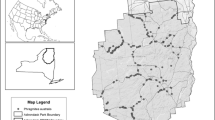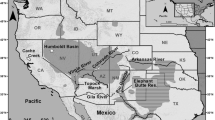Abstract
The control of invasive alien plants often involves the integration two or more approaches, including mechanical clearing, the application of herbicides, burning, and biological control. More than one species of invasive plant can threaten the same area, which necessitates prioritization in the allocation of scarce resources to support the control of different species. This paper describes the integrated control of the invasive shrub Hakea sericea over four decades in South Africa. The species is widespread across an area of approximately 800 × 200 km, and occurs mainly in rugged, inaccessible and fire-prone mountain areas. The species is serotinous, and produces copious amounts of seed that are wind dispersed after fires. We present a brief history of the control measures which included a combination of felling and burning, augmented by biological control. We used data from two surveys, 22 years apart, to assess changes in distribution and density of the species. The assessment suggested that the overall distribution of the species was reduced by 64%, from ~530,000 to ~190,000 ha between 1979 and 2001. The species either decreased in density, or was eliminated from 492,113 ha, while it increased in density, or colonised 107,192 ha. We conclude that initial programs of mechanical clearing were responsible for reducing the density and extent of infestations, and biological control was largely responsible for the failure of the species to re-colonize cleared sites, or to spread to new areas following unplanned wildfires. We propose that a significant portion of the resources used for clearing Hakea in the past can be reallocated to mechanical control efforts against other invasive species (such as alien pines) for which effective biological control options are not available, provided that sufficient resources are allocated to ensure the widespread and effective implementation of all biological control agents to maintain the advances reported on here.
Similar content being viewed by others
References
Bands DP (1977) Prescribed burning in Cape fynbos catchments. In: Mooney HA, Conrad CE (eds) Proceedings of the symposium on the environmental consequences of fire and fuel management in Mediterranean ecosystems. Palo Alto California, August 1977. USDA Forest Service general Technical report WO-3, pp 245–256
Fenn JA (1980) Control of Hakea in the Western Cape. In: Proceedings of the Third National Weeds Conference of South Africa, Balkema, Cape Town
Forsyth GG, van Wilgen BW (2007) Analysis of the fire history records from protected areas in the Western Cape. Report CSIR/NRE/ECO/ER/2007/0118/C. CSIR, Stellenbosch
Fugler SR (1979) Some aspects of the autecology of three Hakea species in the Cape Province, South Africa. Dissertation, University of Cape Town
Fugler SR (1983) The control of silky hakea in South Africa. Bothalia 14:977–980
Gordon AJ (1993) The impact of the Hakea seed-moth Carposina autologa (Carposinidae) on the canopy-stored seeds of the weed Hakea sericea (Proteaceae). Agric Ecosyst Environ 45:103–113. doi:10.1016/0167-8809(93)90062-T
Gordon AJ (1999) A review of established and new insect agents for the biological control of Hakea sericea Schrader (Proteaceae). South Africa. Afr Entomol mem 1:35–43
Gordon AJ (2003) Biology and host range of the stem-boring beetle Aphanasium australe, a promising agent for the biological control of Hakea sericea in South Africa. BioControl 49:341–355
Grand J, Cummings MP, Rebelo TG et al (2007) Biased data reduce efficiency and effectiveness of conservation reserve networks. Ecol Lett 10:364–374. doi:10.1111/j.1461-0248.2007.01025.x
Holmes PM, Richardson DM, van Wilgen BW et al (2000) The recovery of South African fynbos vegetation following alien tree clearing and fire: implications for restoration. Austral Ecol 25:631–639. doi:10.1046/j.1442-9993.2000.01063.x
Kluge RL, Gordon AJ (2004) The fixed plot survey method for determining the host range of the flowerbud-feeding weevil Dicomada rufa, a candidate for the biological control of Hakea sericea in South Africa. BioControl 48:113–122
Kluge RL, Neser S (1991) Biological control of Hakea sericea (Proteaceae) in South Africa. Agric Ecosyst Environ 37:91–113. doi:10.1016/0167-8809(91)90141-J
Kluge RL, Richardson DM (1983) Progress in the fight against hakea. Veld & Flora 69:136–138
Le Maitre DC, van Wilgen BW, Chapman RA et al (1996) Invasive plants and water resources in the Western Cape Province, South Africa: modelling the consequences of a lack of management. J Appl Ecol 33:161–172
Le Maitre DC, Krug RM, Hoffman JH et al (2008) Hakea sericea: development of a model of the impacts of biological control on population dynamics and rates of spread of an invasive species. Ecol Model 212:342–358
Lubbe CM, Denman S, Cannon PF et al (2004) Characterization of Colletotrichum species associated with diseases of Proteaceae. Mycologia 96:1268–1279
Macdonald IAW, Richardson DM (1986) Alien species in the terrestrial ecosystems of the fynbos. In: Macdonald IAW, Kruger FJ et al (eds) The ecology and management of biological invasions in Southern Africa. Oxford University Press, Cape Town, pp 77–91
Marais C, van Wilgen BW, Stevens D (2004) The clearing of invasive alien plants in South Africa: a preliminary assessment of costs and progress. S Afr J Sci 100:97–103
Moody ME, Mack RN (1988) Controlling the spread of plant invasions: the importance of nascent foci. J Appl Ecol 25:1009–1021
Mooney HA, Mack RN, Mcneely JA et al (2005) Invasive alien species: a new synthesis. Island Press, Washington
Moran VC, Hoffmann J, Donnelly D et al (2000) Biological control of alien invasive pine trees (Pinus species) in South Africa. In: Spencer NR (ed) Proceedings of the Xth International Symposium on Biological Control of Weeds, CSIRO Entomology, Canberra, Australia, pp 941–953
Moran VC, Hoffmann JH, Olkers T (2004) Politics and ecology in the management of alien woody invasive woody trees: the pivotal role of biocontrol agents that diminish seed production. In: Cullen JM et al (eds) Proceedings of the XI International Symposium on Biological Control of Weeds, CSIRO Entomology, Canberra, Australia, pp 434–439
Morris MJ (1983) Evaluation of field trials with Colletotrichum gloeosporioides for the biological control of Hakea sericea. Phytophylactica 15:13–16
Morris MJ (1989) A method for controlling Hakea sericea Schrad. seedlings using the fungus Colletotrichum gloeosporioides (Penz.) Sacc. Weed Res 29:449–454
Neser S, Fugler SR (1983) Silky hakea. In: Stirton CH (ed) Plant invaders: beautiful but dangerous. Department of Nature and Environment Conservation of the Cape Provincial Administration, Cape Town, pp 76–79
Richardson DM, Brown PJ (1986) Invasion of mesic mountain fynbos by Pinus radiata. S Afr J Bot 52:529–536
Richardson DM, Manders PT (1985) Predicting pathogen-induced mortality in Hakea sericea (Proteaceae), an aggressive alien plant invader in South Africa. Ann Appl Biol 106:243–254
Richardson DM, van Wilgen BW, Mitchell DT (1987) Aspects of the reproductive ecology of four Australian Hakea species (Proteaceae) in South Africa. Oecologia 71:1432–1939
Stirton CH (1978) Plant invaders: beautiful, but dangerous. Department of Nature Conservation of the Cape, Cape Town, p 175
van Wilgen BW, Kruger FJ (1981) Observations on the effects of fire in mountain fynbos at Zachariashoek, Paarl. S Afr J Bot 47:195–212
van Wilgen BW, Richardson DM (1985) The effects of alien shrub invasions on vegetation structure and fire behaviour in South African fynbos shrublands: a simulation study. J Appl Ecol 22:955–966
van Wilgen BW, Everson CS, Trollope WSW (1990) Fire management in southern Africa: some examples of current objectives, practices and problems. In: Goldammer JG (ed) Fire in the tropical biota: ecosystem processes and global challenges. Springer, Berlin, pp 179–209
van Wilgen BW, Little PR, Chapman RA et al (1997) The sustainable development of water resources: history, financial costs and benefits of alien plant control programmes. S Afr J Sci 93:404–411
van Wilgen BW, Le Maitre DC, Cowling RM et al (1998) Ecosystem services, efficiency, sustainability and equity: South Africa’s working for water programme. Trends Ecol Evol 13:378
van Wilgen BW, Marais C, Magadlela D (2002) Win-win-win: South Africa’s Working for Water programme. In: Pierce SM et al (eds) Mainstreaming biodiversity in development: case studies from South Africa. Washington DC, The World Bank, pp 5–20
Versfeld DB, van Wilgen BW (1986) Impact of woody aliens on ecosystem properties. In: Kruger FJ et al (eds) The ecology and management of biological invasions in Southern Africa. Oxford University Press, Cape Town, pp 239–257
Wicht CL (1945) Preservation of the vegetation of the south-western Cape. Special publication of the Royal Society of South Africa, Cape Town
Acknowledgments
We thank the South African National Research Foundation (K. J. Esler, GUN 2053516 and through the Centre for Invasion Biology), and the Working for Water Programme for funding, and Dave Richardson and John Hoffman for useful comments on an earlier version of this manuscript, and Tony Rebelo for advice regarding the use of Protea Atlas Data.
Author information
Authors and Affiliations
Corresponding author
Rights and permissions
About this article
Cite this article
Esler, K.J., van Wilgen, B.W., te Roller, K.S. et al. A landscape-scale assessment of the long-term integrated control of an invasive shrub in South Africa. Biol Invasions 12, 211–218 (2010). https://doi.org/10.1007/s10530-009-9443-2
Received:
Accepted:
Published:
Issue Date:
DOI: https://doi.org/10.1007/s10530-009-9443-2




